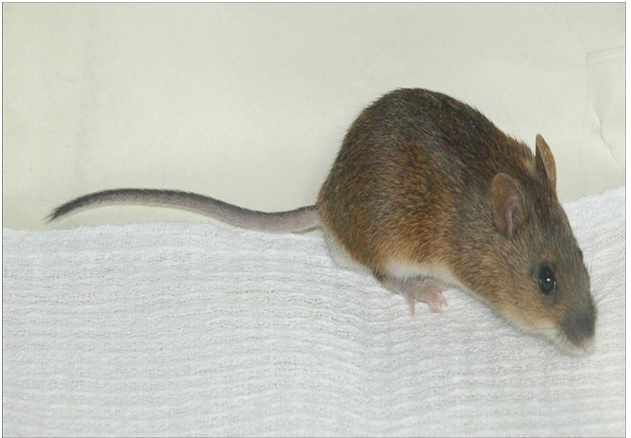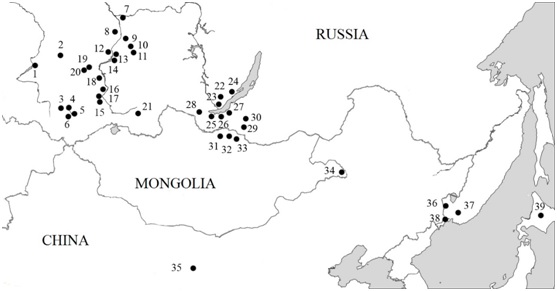B chromosome database of the Korean field mouse / База B-хромосом корейской мыши (Apodemus peninsulae Thomas, 1907)
If you need the database in another format, please, address Yuri Borisov boriss-spb@yandex.ru / Если для работы вам необходима база в другом формате, обращайтесь, пожалуйста, к Юрию Михайловичу Борисову boriss-spb@yandex.ru
The Korean field mouse

B chromosome system in the Korean field mouse (Apodemus peninsulae Thomas 1907 (Rodentia, Muridae))
Yuri M. Borisov 1*
1 Severtzov Institute of Ecology and Evolution, Russia Academy of Sciences, Leninsky Pr., 33, 119071 Moscow, Russia; boriss-spb@yandex.ru
* Correspondence: boriss-spb@yandex.ru ; Tel.: +007-925-837-3070
Keywords: B chromosomes, dotlike (micro Bs), karyotypic characteristics, Вs, B morphotypes, Korean field mouse, Apodemus peninsulae
Introduction
The Korean field mouse (Apodemus peninsulae Thomas, 1907) is widely distributed from East Siberia and North Mongolia, the Russian Far East to China, Korea and Japan (Hokkaido) (Figure 1). A. peninsulae belongs to the genus Apodemus, in which six species have been shown to carry B chromosomes [1]. А. peninsulae shows one of the widest spectrum of Bs variability (1-30) among animals. Through the wide geographical range mice karyotypes contain from 48 to 78 chromosomes and the vast majority of individuals of this species have extra chromosomes [2-18]. The only population lacking B chromosomes is known from Sakhalin Island, Russia [10]. The Korean field mouse extra chromosomes highly vary in morphology. The majority of mammals with Bs usually have extra chromosomes of one type, such as acrocentric in Apodemus (Sylvaemus) flavicollis Melchior, 1834 or metacentric in Rattus rattus Linnaeus, 1758 [19]. In A. peninsulae up to five morphotypes were revealed (see below).


Polymorphism of extra chromosomes in A. peninsulae has already been found in 1970s while investigating mice karyotypes from Hokkaido, Japan [20]. A range from small dotlike to large metacentric chromosomes was discovered. However, a relative homogeneity of Bs including only small and medium metacentric chromosomes was found in mainland part of the species range (from Altai to Primorsky Region) [2,4,12]. Further expanding of catching localities in Central Siberia has demonstrated that mainland populations could also have high variety of B chromosomes [13,15] leading to onward investigation of geographic variability of Bs morphotypes in the Korean field mouse [1,6,7,11,15,18,21-27].
The accumulated knowledge on morphological systems of extra chromosomes in A. peninsulae raises new questions: how to estimate population variability of the species through patterns of its B chromosome variability; what meaning B chromosome morphology could have related to its molecular features; how B chromosomes are originated and inherited?
For over 40 years of the current study nearly 600 individuals of A. peninsulae from different parts of its range were karyotyped, made it possible to create an extensive database and to analyze extra chromosome morphotypes in various geographically distant local populations.
The Korean field mouse has thus become a good mammalian model for studies of evolutionary dynamics and effects of Bs on the host genome. The aim of this paper is to report new data on extra chromosomes distribution in local populations of the Korean field mouse A. peninsulae (Rodentia, Muridae) that would provide determining future directions for investigations.
MATERIALS AND METHODS
We examined chromosomal data in 598 A. peninsulae individuals collected at 39 local populations in Russia, Mongolia, China, Korea and Japan. 418 individuals from 30 localities were collected in Siberia (Central Siberia, Altai, Khakassia, Tyva, Baikal Lake region and Buryatia); 94 individuals were collected from Primorsky krai (The Russian Far East); 60 individuals were collected in Mongolia; 8 individuals were collected in Gansu province of China. We also used published data on 18 individuals from Hokkaido, Japan [20] (Figure 1, Table 1).

Our own developed formula was applied for morphotype numerical coding of B chromosomes [21]. The first number indicates B chromosomes of I class: large bi-armed chromosomes equal to 1-8 pairs of A chromosomes (large metacentrics). The second number indicated B chromosomes of II class: medium sized bi-armed chromosomes equal to 9-16 pairs of A chromosomes (medium metacentrics). The third number indicates B chromosomes of III class: small bi-armed chromosomes equal to 17-23 pairs of A chromosomes (small metacentrics). The forth number indicates B chromosomes of IV class: small acrocentric chromosomes equal to 17-23 pairs of A chromosomes. Finally, the fifth number indicates B chromosomes of V class or dotlike chromosomes (micro Bs). For example, the formula 1.1.1.1.1 means that an individual has five B chromosomes, one in each of five classes. By our opinion, both the ratio of different Bs morphotypes and the variety of total amount of chromatin in extra chromosomes are highly significant to reveal the origin and specific existence of extra chromosomes [23,24]. To estimate the amount of chromatin, we used conditional "mass quantity" of B chromosomes (mB index), developed by G.V. Roslik and I.V. Kartavtseva [14]. In this case, one conditional point is assigned to each size class: one point to dotlike (micro Bs) (V class), two points to larger and relatively similar in size chromosomes of IV and III classes, three points to II class and four points to I class chromosomes. The sum of points demonstrates a certain characteristics of Bs mass quantity.
Localities were aggregated according to distances and presence/absence of geographical, especially water, barriers between them.
The statistical analysis using standard techniques was conducted in Statistica 8.0 Software [29].
The standard (A) diploid set of A. peninsulae contains 48 acrocentric chromosomes gradually decreasing in size (Figure 2a). In addition, up to 30 supernumerary (B) chromosomes may be found in some individuals. In this paper, we divide B chromosomes into two groups according to their size. The first group includes Bs of visible morphology under light microscopy (macro Bs), which are larger or equal in size to the smallest A chromosome. The second group includes only dot-like chromosomes which are much smaller than A chromosomes and without clear morphology (micro Bs). The macro B chromosomes are divided into classification types according to their morphology and relative size in comparison with the A chromosomes (Figure 2b). No A chromosome aberrations despite high variability of B chromosomes were not found.
We have previously described four types of macro Bs [13]: (1) large metacentrics or submetacentrics (Lm-sm); (2) medium-to-small metacentrics or submetacentrics (Mm-sm); (3) small metacentric (mm); (4) large-to-small acrocentrics or subtelocentrics (A-St). The most frequent macro Bs in A. peninsulae are Mm-sm (Fig. 2a), whereas A-St morphological variants of medium or small size are rare. In some cases we could identify the morphology of micro Bs in good quality metaphase plates, but in most cases micro Bs looked like very small structures without clear morphology.
Figure. 2. Karyotype of A. peninsulae: (a) the main set of 48 acrocentric A chromosomes and (b) variants of five (I–V) classes of B chromosomes. Formulas of Bs are 12.2.5.2.1.2.
We suppose that dotlike (micro B) chromosomes are initial and originated by duplication of centromeric areas of A chromosomes with further reorganization into macro Вs through DNA ampliphication [23,24].
(Apodemus peninsulae Thomas, 1907) is widely distributed from East Siberia and North Mongolia, the Russian Far East to China, Korea and Japan (Hokkaido) (Figure 1). A. peninsulae belongs to the genus Apodemus, in which six species have been shown to carry B chromosomes [1]. А. peninsulae shows one of the widest spectrum of Bs variability (1-30) among animals.
Through the wide geographical range mice karyotypes contain from 48 to 78 chromosomes and the vast majority of individuals of this species have extra chromosomes [2-18]. The only population lacking B chromosomes is known from Sakhalin Island, Russia [10]. The Korean field mouse extra chromosomes highly vary in morphology. The majority of mammals with Bs usually have extra chromosomes of one type, such as acrocentric in Apodemus (Sylvaemus) flavicollis Melchior, 1834 or metacentric in Rattus rattus Linnaeus, 1758 [19]. In A. peninsulae up to five morphotypes were revealed (see below).
The Korean field mouse (Apodemus peninsulae Thomas 1907) is is widely distributed from East Siberia and North Mongolia, China to the Russian Far East, Korea and Japan (Hokkaido) (Fig.1). A. peninsulae belongs to the genus Apodemus, in which six species have been shown to carry B chromosomes (Wo´jcik et al., 2004).
Our own developed formula was applied for morphotype numerical coding of B chromosomes [2]. The first number indicates B chromosomes of I class: large bi-armed chromosomes equal to 1-8 pairs of A chromosomes (large metacentrics). The second number indicated B chromosomes of II class: medium sized bi-armed chromosomes equal to 9-16 pairs of A chromosomes (medium metacentrics). The third number indicates B chromosomes of III class: small bi-armed chromosomes equal to 17-23 pairs of A chromosomes (small metacentrics). The forth number indicates B chromosomes of IV class: small acrocentric chromosomes equal to 17-23 pairs of A chromosomes. Finally, the fifth number indicates B chromosomes of V class or dotlike chromosomes (micro Bs). For example, the formula 1.1.1.1.1 means that an individual has five B chromosomes, one in each of five classes.
References
- Wójcik, J.M.; Wójcik, A.M.; Macholan, M.; Pialek, J.; Zima, J. The mammalian model for population studies of B chromosomes: the wood mouse (Apodemus). Cytogenet Genome Res 2004, 106 (2–4), 264–270. [CrossRef] [PubMed]
- Borisov, Y.M. Cytogenetic structure of Apodemus peninsulae (Rodentia, Muridae) population on the coast of Teletskoye Lake (Altai). Russ J Genet 1990, 26, 1212–1220.
